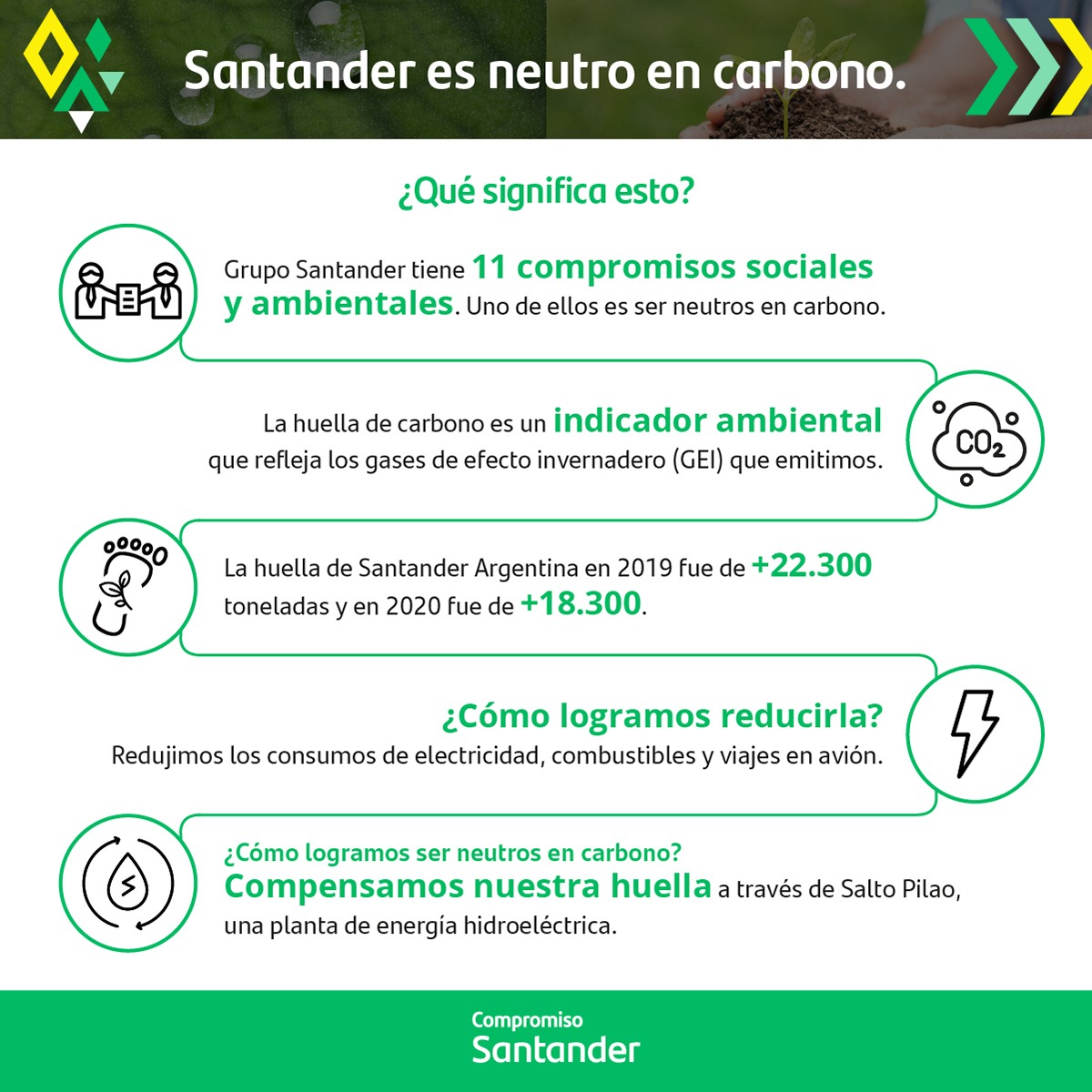Santander Argentina reduces its carbon footprint and has also become carbon neutral in its own operations


The bank became carbon neutral in its own operations last year and offsets its footprint through the Salto Pilão Hydropower Plant Project Activity.
Santander Argentina also reduced its carbon footprint by 17.9% in 2020, from +22,300 to +18,300 VCUs (Verified Carbon Units).

Buenos Aires, 3 May 2021. Santander Argentina achieved a 17.9% reduction in its carbon footprint in the country last year to +18,300 VCUs, down from +22,300 VCUs in 2019, and also decided to offset its emissions to become a carbon-neutral business.
The bank offsets its footprint through the Salto Pilão Hydropower Plant Project Activity. It is currently working globally on an analysis plan for local offsetting proposals.
Santander has 11 public commitments in relation to social and environmental impact including achieving carbon neutrality, consuming energy from renewable sources, eliminating all unnecessary single-use plastics and promoting sustainable financing.
The measurement of Santander Argentina's footprint includes consumption of electricity, natural gas, fuels and short-, medium- and long-haul plane travel. At the same time improvements to measurement are being implemented which will enable more consumptions and their corresponding impact on the indicator to be included.
According to Vanesa Marignan, head of Responsible Banking at Santander Argentina, reporting our carbon footprint "is a way of measuring our environmental impact so that we can draw up reduction and offsetting plans, in this way reaffirming our commitment to inclusive and sustainable growth".
Pamela Landini, who is responsible for environmental issues in Santander Argentina's Responsible Banking team, added that "the carbon footprint reduction programmes in our country included energy efficiency plans based on such measures as the replacement of LED lighting in our branch network and the inclusion of inverter technology in air conditioning systems. We are supplementing these initiatives by reducing our environmental impact through the elimination of single-use plastic, the separation of waste for recycling by cooperatives, environmental management systems certified under the ISO 14001 international standard and the promotion of sustainable financing".
A carbon footprint is an environmental indicator that reflects the total amount of greenhouse gases (GHG) emitted by people and companies, measured in carbon dioxide equivalent (CO2e). Among the most significant greenhouse gases are water vapour, carbon dioxide (CO2) and methane (CH4). GHGs cause global warming, which is why it is essential that we reduce our environmental footprint, i.e. GHGs.
A carbon footprint is calculated by measuring, inter alia, consumption of electricity, natural gas and fuels. Each consumption has a specific unit of measurement, which is converted into tonnes of CO2.
With a view to fostering environmentally responsible habits, the #SantanderCommitment supports a range of environmental training which it offers in partnership with organisations.
At the start of 2021, the group executive chairman of Santander Group, Ana Botín, announced a plan to make all of the Group's activity net zero by 2050. As well as including neutrality in its own activity, as is the case at present, it also extends both to the group's own activity and all the emissions of its customers from any of the financing, advisory or investment services provided by Santander.
Santander Group has also been a member of the Net Zero Banking Alliance (NZBA) since April 2021. This means that in addition to pledging to be CO2 neutral (ambition to be net zero by 2050), it is endeavouring to offset other GHG emissions (carbon emissions account for 70-80% of GHG emissions and the other 20-30% includes nitrous oxide and methane).
How can carbon neutrality be achieved?
In two ways: by eliminating or offsetting emissions. Compensation is not a substitute for reduction, but it is complementary for any remaining emissions it is not possible to reduce at the moment.
Carbon neutrality is achieved when an organism, a company or an individual takes the physical measures necessary to stop emitting CO2 into the atmosphere, thereby reducing the carbon footprint.
About Santander Argentina's commitment to responsible banking
Santander Argentina is committed to helping people and businesses prosper by fostering inclusive and sustainable growth. This is why we are carrying out a variety of educational, social and environment initiatives to achieve a threefold impact.
In 2020, more than 460,000 people benefitted from the support of Santander through various community-focused programmes. More than 40 projects with a social and environmental impact were included in the Committed SuperClub programme, promoting responsible consumption and entrepreneurship. The involvement of Santander employees was fostered through more than 3,600 hours of volunteering. Investment was made in financial education benefitting thousands of people.
Initiatives were also promoted to reduce environmental impact including financing facilities for individuals, SMEs and companies for sustainable products and sustainable development products and a special credit line for the purchase of electric cars.
To find out more about Santander's Commitment please consult the Consolidated Activities and Responsible Banking Report: santander.com.ar/informesantander2020
About Santander Argentina
Santander Argentina is the largest private bank in Argentina’s financial system in terms of deposits. It has 400 traditional branches, eight social integration branches, three digital branches, three Work Cafés and more than four million customers (including 2.2 million digital customers, more than 320,000 MSMEs and 1,300 corporate companies). It has a team of more than 8,000 employees and is present in 22 provinces and in the city of Buenos Aires. Santander Argentina is developing an extensive responsible banking programme focusing on higher education and has over 86 collaboration agreements in place with public and private universities in the country.

